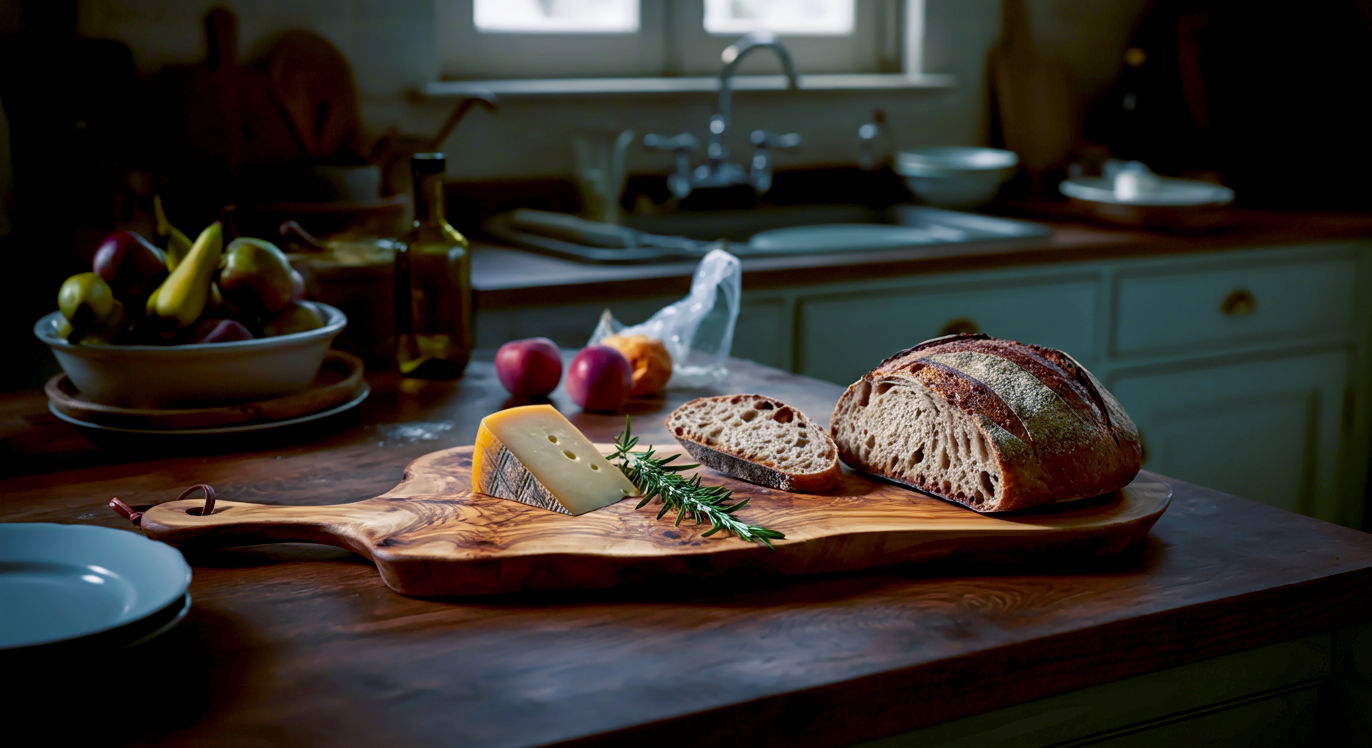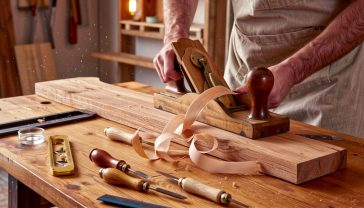The Guide to Olive Wood: From Ancient Groves to Your Kitchen
What is olive wood? Explore the ultimate guide to this beautiful, durable, and sustainable material, from its rich history to its perfect uses in your kitchen.

This post may contain affiliate links. If you make a purchase through these links, we may earn a commission at no additional cost to you.
It’s a funny thing, isn’t it? You can hold a simple wooden spoon in your hand and feel a connection to something ancient. And if that spoon is made from olive wood, you’re not just holding a piece of timber; you’re holding a piece of history. With its stunning, swirling patterns and a story that stretches back thousands of years, olive wood isn’t just beautiful—it’s a little bit magical.
For many of us here in Britain, our first encounter with proper olive wood might have been on a sun-drenched holiday in Spain, Greece, or Italy. You wander into a little gift shop and there it is: a beautiful chopping board with a grain so wild and chaotic it looks like a landscape painting. Or maybe it was a set of salad servers, smooth and warm to the touch. It feels different from the oak, pine, and beech we’re used to. It feels special.
But what exactly is olive wood? Why does it look so dramatic, and why is it so prized? Is it just for holiday souvenirs, or is it a practical choice for our homes?
This guide is here to answer all those questions and more. We’re going to take a deep dive into the world of this remarkable material. We’ll explore the ancient trees it comes from, uncover its deep roots in history and culture, and find out what makes it one of the most distinctive and cherished woods on the planet. From the sun-baked groves of the Mediterranean to the heart of your British kitchen, let’s uncover the story of olive wood.
What Is Olive Wood and Where Does It Come From?
At its heart, olive wood is exactly what it says on the tin: it’s the wood that comes from the olive tree (Olea europaea). But this isn’t just any old tree. The olive tree is one of the most iconic and long-lived plants in the world, a true symbol of peace, longevity, and the Mediterranean way of life.
The Legendary Olive Tree
Before we can understand the wood, we need to appreciate the tree. Olive trees are proper survivors. They can live for centuries, sometimes even millennia. There are trees in the Mediterranean today that were seedlings when the Roman Empire was at its peak.
They thrive in places with hot, dry summers and mild, wet winters—think of the rolling hills of Tuscany, the dusty plains of Andalusia, or the rocky coastlines of Greece. These tough growing conditions are exactly what give the wood its character. The tree grows slowly and gets twisted and gnarled by the wind and sun over hundreds of years. This slow, difficult life is what creates the dense, beautiful grain we love.
Most of the olive wood you’ll find for sale comes from countries like Spain, Italy, Greece, and Tunisia. These regions have vast olive groves where the trees are cultivated primarily for their fruit—the olives that give us delicious olive oil.
A Sustainable and Ethical Choice?
Here’s something important you should know: olive trees are almost never chopped down just for their wood. They are far too valuable for the oil they produce. The wood is a by-product, a gift from the tree at the end of its long and fruitful life.
Olive wood is typically harvested only after a tree has stopped producing good quality olives, which can take hundreds of years. Sometimes, branches are pruned to keep the tree healthy and encourage new growth, and this pruned wood is also used. This makes it a wonderfully sustainable and ethical material. You’re not contributing to deforestation; you’re giving a new purpose to a tree that has already given so much.
This process is a world away from the mass-produced timber industries. It’s slow, careful, and respectful. Each piece of wood is a testament to the tree’s long life, and that’s a pretty special thing to bring into your home.
The Unique Look and Feel of Olive Wood
Put a piece of olive wood next to a piece of pine or oak, and the difference is obvious. Olive wood doesn’t do subtle. It’s bold, dramatic, and utterly captivating. Its appearance is its signature, and it’s what makes people fall in love with it.
The Famous Grain Pattern
The most striking feature of olive wood is its grain. It’s not straight and uniform like many other woods. Instead, it’s a wild, beautiful mess of swirls, curls, and contrasting colours. You’ll see rich, creamy shades of yellow and beige intertwined with darker, dramatic streaks of brown and even black.
Why does it look like this? It’s all down to the tree’s slow, twisted growth. Over hundreds of years, the tree battles the elements, and its trunk and branches become gnarled and contorted. This struggle is recorded in the wood, creating the unique, chaotic patterns. No two pieces of olive wood are ever the same. Each one has its own story etched into its grain. It’s like a wooden fingerprint.
The contrast between the lighter sapwood (the younger, outer layers of the tree) and the darker heartwood (the older, central part) adds to this incredible visual depth.
It’s Not Just a Pretty Face: The Physical Properties
Beyond its good looks, olive wood is a seriously impressive material. It has a combination of properties that make it both beautiful and incredibly practical.
It’s Incredibly Hard and Dense
If you pick up a piece of olive wood, the first thing you’ll notice is its weight. It’s surprisingly heavy. This is because it’s a very dense hardwood. The Janka hardness test, which measures how resistant a wood is to denting, gives olive wood a rating of around 2,700 pounds-force. To put that in perspective, English Oak scores about 1,120. This makes olive wood extremely durable and resistant to scratches and dings. It’s tough stuff.
A Natural Protector: High Oil Content
Olive trees are full of oil—that’s their whole point! And this natural oil doesn’t just stay in the fruit; it’s present throughout the wood. This high oil content gives the wood a natural sheen and a wonderfully smooth, silky feel.
More importantly, these oils act as a natural preservative. They make the wood highly resistant to moisture, which is why it doesn’t stain or absorb odours and flavours easily. This is a massive plus for kitchen utensils. Your olive wood chopping board won’t smell of garlic after you’ve used it, and your spoon won’t taste of last night’s curry.
This oily nature also means it has natural antibacterial properties. The dense, non-porous surface gives germs nowhere to hide, making it a safe and hygienic choice for food preparation.
That Unmistakable Scent
One of the loveliest things about olive wood is its smell. When you first get a new piece, or when you’re washing it, you’ll notice a faint, sweet, and slightly fruity aroma. It’s a subtle, pleasant scent that instantly transports you to a sunny Mediterranean grove. It’s part of the whole sensory experience of using it.
A Journey Through Time: Olive Wood in History
Olive wood is more than just a material; it’s woven into the fabric of human history, particularly in the cultures surrounding the Mediterranean. Its story is one of spirituality, utility, and artistry that stretches back to the dawn of civilisation.
The Sacred and the Spiritual
For ancient civilisations, the olive tree was a direct gift from the gods. In Greek mythology, the goddess Athena struck her spear into the ground of the Acropolis, and from it sprang the very first olive tree. It was a symbol of peace, wisdom, and prosperity, and the city of Athens was named in her honour.
This reverence for the tree naturally extended to its wood. Olive wood was considered sacred. It was used to carve religious artefacts, statues of gods and goddesses, and ceremonial objects. Its branches were woven into crowns to honour the victors of the original Olympic Games—a symbol of supreme achievement.
This spiritual significance continues in Abrahamic religions. In the Bible, an olive branch is brought back to Noah by a dove, signalling the end of the great flood and a new beginning for humanity. To this day, the olive branch remains a powerful and universal symbol of peace. Many religious items, such as rosary beads and crosses, are still carved from olive wood from the Holy Land, cherished for their connection to this sacred history.
From Ancient Tools to Roman Luxury
Beyond the sacred, olive wood was a vital part of everyday life. Its hardness and durability made it perfect for crafting practical items. Archaeologists have unearthed ancient tools, farming implements, and simple household bowls made from this reliable wood.
The Romans, with their appreciation for both form and function, elevated the use of olive wood. They used it not just for tools but also for creating more refined objects. Wealthy Roman villas might have featured small, decorative items or intricate inlays made from olive wood, prized for its beautiful grain. They understood that it was both tough and beautiful, a rare combination.
The Enduring Craft Tradition
This tradition of craftsmanship has never died out. For centuries, artisans in Mediterranean villages have passed down the skills of working with olive wood from one generation to the next. These small, family-run workshops are the heart of the olive wood industry.
They understand the wood’s tricky, twisted nature. They know how to read the grain and how to cut it to reveal its most beautiful patterns. They work with the wood, not against it, letting its natural form guide the shape of the final product. When you buy a hand-carved olive wood bowl, you’re not just buying an object; you’re supporting a tradition that is thousands of years old.
Olive Wood in the Modern British Home
So, we’ve seen that olive wood has a rich history and fantastic properties. But how does it fit into our lives today, here in the UK? The answer is: beautifully. Its combination of rustic charm and practical toughness makes it a perfect addition to the modern British home.
The Heart of the Home: The Kitchen
The kitchen is where olive wood truly shines. Its natural properties make it a superstar for anything related to food.
- Chopping Boards and Cutting Boards: This is probably the most popular use for olive wood, and for good reason. They are incredibly hard-wearing, so they won’t be scarred by your sharpest kitchen knives. The natural oils prevent them from absorbing juices from meat or strong flavours from things like onions and garlic. Plus, they are so beautiful that they double up as serving platters for cheese, charcuterie, or bread. An olive wood board can be the centrepiece of your dining table.
- Utensils (Spoons, Spatulas, Salad Servers): Olive wood utensils are a joy to use. They feel warm and organic in your hand, unlike cold metal or flimsy plastic. They are strong enough to stir the thickest stews but gentle enough that they won’t scratch your non-stick pans. Their non-porous nature means they are hygienic and easy to clean.
- Bowls: From a small bowl for serving olives (how fitting!) to a large fruit bowl, olive wood bowls are both practical and stunning. The unique grain of each bowl makes it a one-of-a-kind piece of functional art for your countertop.
- Pestles and Mortars: The sheer density and hardness of olive wood make it an ideal material for grinding herbs and spices. It’s tough enough to withstand the pounding and won’t absorb the strong aromas of the spices you’re grinding.
Beyond the Kitchen: Decorative Items
While the kitchen is its natural home, the beauty of olive wood lends itself to all sorts of decorative items around the house.
- Coasters: A set of olive wood coasters adds a touch of rustic elegance to any coffee table, protecting your surfaces while looking stylish.
- Candle Holders: The warm tones of the wood pair beautifully with the gentle flicker of candlelight, creating a cosy, welcoming atmosphere.
- Jewellery Boxes and Ornaments: Smaller, more intricate items really allow the beauty of the grain to be showcased. These make wonderful, unique gifts.
- Furniture?: You might be wondering about larger items. Olive wood furniture is very rare. Because the trees are gnarled and don’t grow very large or straight, it’s difficult to get big, uniform planks of timber. You might occasionally see a small coffee table or a piece with olive wood veneer, but large-scale furniture is not what this wood is used for. It’s a wood for special, cherished items, not for mass production.
Caring for Your Olive Wood: A Simple Guide
One of the best things about olive wood is that it’s surprisingly low-maintenance. It’s a tough material that’s built to last, but a little bit of care will keep it looking its best for years, or even generations.
The golden rule is simple: keep it oiled, and keep it out of the dishwasher.
The Dos and Don’ts of Cleaning
- DO wash by hand. After you’ve used your olive wood item, wash it in warm (not hot) water with a little bit of washing-up liquid.
- DO dry it immediately. Don’t leave it to soak in the sink, and don’t let it air dry. Use a tea towel to dry it thoroughly straight after washing. This is the single most important step to prevent the wood from cracking.
- DON’T put it in the dishwasher. Ever. The intense heat, prolonged exposure to water, and harsh detergents of a dishwasher will strip the natural oils from the wood, causing it to dry out, fade, and eventually crack or warp. It’s the quickest way to ruin a beautiful piece.
- DON’T use harsh cleaning pads. A soft sponge or cloth is all you need. A metal scourer will scratch the surface.
Bringing Back the Shine: Oiling Your Wood
Over time, you might notice that your olive wood starts to look a bit dry or dull. This is perfectly normal. It just means it’s thirsty and needs a bit of oil to bring its colour and shine back to life. This is a simple and very satisfying job.
How often should you oil it? It depends on how often you use and wash it. A good rule of thumb is about once a month, or whenever it starts to look a bit pale.
What kind of oil should you use? You don’t need anything fancy. Any food-safe oil will do the job. Here are some good options:
- Mineral Oil: This is the top choice for many wood experts. It’s cheap, readily available from chemists or hardware shops, has no smell or taste, and it won’t go rancid.
- Olive Oil?: It seems like the obvious choice, doesn’t it? You can use olive oil, but it can go sticky and rancid over time. It’s fine for a quick touch-up, but mineral oil is better for a proper treatment.
- Other Vegetable Oils: Sunflower or rapeseed oil will also work well.
- Specialist Wood Butters: You can buy special “wood butters” or “board creams,” which are often a mix of mineral oil and beeswax. These are fantastic and give a lovely finish, but they are more expensive.
How to oil your olive wood:
- Make sure the item is clean and completely dry.
- Take a clean cloth or a piece of kitchen roll and apply a small amount of oil.
- Gently rub the oil all over the surface of the wood, in the direction of the grain.
- Leave it to soak in for a few hours, or even overnight if it’s very dry.
- After it has had a good drink, take a clean, dry cloth and buff off any excess oil.
That’s it! The deep, rich colours of the grain will pop back to life, and the wood will have a beautiful, healthy sheen. It’s like magic.
Is Olive Wood Sustainable? The Bigger Picture
In a world where we’re all trying to make more conscious choices, the question of sustainability is a big one. When it comes to olive wood, the answer is largely positive, but with a few things to keep in mind.
The Good News: A By-Product of a Fruit Harvest
As we’ve discussed, the biggest tick in the sustainability box for olive wood is that it’s a by-product. The trees are grown for their olives, not their timber. The wood only becomes available when a tree is too old to produce fruit or when branches are pruned for the tree’s health.
This means that buying an olive wood product isn’t driving deforestation in the same way as buying furniture made from tropical hardwoods might be. You’re essentially recycling a resource that would otherwise be discarded or used as firewood. The lifecycle of the olive tree is incredibly long and productive, and using its wood at the very end is a great example of using a natural resource to its fullest potential.
Things to Be Aware Of
While the story is mostly good, it’s worth being a mindful consumer.
- Source and Traceability: The best olive wood comes from small, artisanal workshops that have a close relationship with the local olive growers. When you buy from reputable sellers, you are often supporting these small, rural economies and traditional crafts. Be wary of very cheap, mass-produced items where the source is unclear.
- Ancient Trees: Some of the oldest olive trees are protected as natural monuments. It’s illegal to cut these down. The industry is generally well-regulated, but it’s another reason to buy from trusted sources who respect the laws and the heritage of these magnificent trees.
- Finishes: Most high-quality olive wood is simply finished with olive oil or mineral oil to enhance its natural beauty. Some cheaper products might be coated in varnishes or lacquers that contain chemicals. The natural, oil-finished pieces are not only more authentic but also better for the environment and safer for food contact.
Overall, if you buy a piece of authentic, hand-crafted olive wood from a reputable source, you can feel confident that you’re making a responsible and sustainable choice.
The Future of Olive Wood
Olive wood has been cherished by humans for millennia, and it’s not going anywhere. Its timeless appeal and fantastic properties ensure that it will always be in demand. However, the world is changing, and this ancient material faces some modern challenges.
Climate change poses a threat to the olive groves of the Mediterranean, with droughts and extreme weather patterns affecting the health of the trees. Diseases like Xylella fastidiosa, a bacterium that is deadly to olive trees, have caused devastation in some parts of Italy.
But the future is also bright. There is a growing appreciation among consumers for natural, sustainable, and handcrafted products. People are turning away from mass-produced plastic and looking for items with a story, with character, and with a connection to the natural world. Olive wood ticks all of these boxes.
As long as the sun shines on the Mediterranean hills and there are skilled artisans to work with this incredible wood, it will continue to bring a touch of natural beauty and ancient history into our homes. It’s a legacy that has been passed down for thousands of years, and one that we now have the pleasure of being a part of. Holding a piece of olive wood is a reminder that some things in life are made to be treasured, to be used, and to last. And in our fast-paced, disposable world, that’s a very comforting thought indeed.
Further Reading & Resources
For those interested in exploring further, these resources provide excellent information on wood properties, olive cultivation, and sustainable forestry:
- The Wood Database: An extensive online resource with technical data on hundreds of wood species, including olive wood.
- The Olive Oil Source: While focused on oil production, this site offers a wealth of information about the olive tree itself, its cultivation, and its history.
- Forest Stewardship Council (FSC UK): Learn more about sustainable forestry practices and what to look for when buying wood products in the UK.






